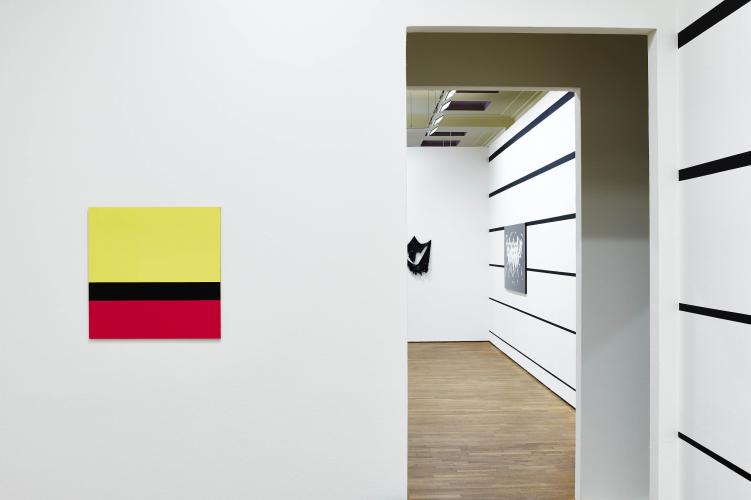
The Oracular Illusion
Scrutinizing points of contact between art and music, interpreting myths spawned by rock or underground culture, manipulating its codes and symbols: these operations recur like leitmotifs in the art and artistic journey of Elodie Lesourd (1978*; lives and works in Paris).
Elodie Lesourd uses the back-and-forth movement between art and music to develop an ontological and aesthetic reflection on each of these mediums in a dual body of work. On the one hand, it plays out in a sort of neo-conceptual approach, a means for the artist to analyze the references to rock culture through the prism of art history or with semiotic play. This can mean connecting the extremities of Norwegian black metal band logos to reveal them as mystical pentagrams, or reinterpreting cult band album covers in abstract compositions, or adopting the punk DIY ethos to transform the features of the musical style (T-shirts stripped of their band logos, guitar picks assembled in the form of a flag, for example). On the other hand, hyperrockalism, a concept invented by Elodie Lesourd, is based on the hyperrealistic reproduction of photographs of installations by other artists who reference rock. Following its rules, she works freehand to fully reproduce the photographs as paintings.At first glance, the two approaches seem to be worlds apart: the aesthetically pleasing, flamboyantly colourful hyperrockalism stands in sharp contrast to the abstraction and muted chromatics of its more semiological counterpart. At Casino Luxembourg, Elodie Lesourd offers an atmospheric journey through this twofold yet cohesive world, where the links between the musical and visual realms by turns overtly reveal themselves or hide from view, as if to be better heard.
In the paintings of the hyperrockalism series, which introduce and lend rhythm to the show, the artist works within a certain protocol but with free rein (albeit relative freedom, since it is limited to choosing the photographs). The overall portrayal, fragmentation or disappearance of the original works reflects choices made by the photographers, choices that Elodie Lesourd transcribes in paint. Her action challenges the sovereignty of the installation's creator, calling into question the status of the work and its archiving.
As the visit continues through the Casino Luxembourg galleries, the works extend beyond their frames and the exhibition becomes a composition in its own right. A wall drawing inspired by Sol Lewitt serves as a tablature for works suspended there like musical notes before turning into a new reference, this time to Frank Stella. Further on, hyperrockalist paintings hanging face to face find extension in the flat colour fields of the surrounding walls which gradually converge to form new shades, playing on the relationship of power between the work and its support, between colour and subject matter. Next, visitors are confronted with leather strips that hamper their view and movement, creating a complex web or, once again, a mise en abyme of the visual and conceptual references orchestrated by the artist throughout the exhibition.The exhibition offers an opportunity to see music, or to read it through the works' titles, but it is also punctuated by phantom apparitions akin to ghost tracks, pieces of music that emerge at the end of an album only after minutes of silence. From philosophy to the notion of sacred to mysticism, from popular culture to abstraction, and vice versa, the rich play of contrasting references makes for a fascinating visit.
Bibliography
Berland, Alain, « Entretien / Blind test pop rock avec Elodie Lesourd et Arnaud Maguet », in Particules, n°21, octobre/novembre 2006, p. 14-15. Blanpied, Julien, « D'après », in Hors d'œuvre ‘'When rock gets up your nose !'', n°27, avril - septembre 2011, p. 3.
Lesourd, Elodie, « LE BAPTÊME OU LA MORT. LE BLACK METAL DANS L'ART CONTEMPORAIN, NAISSANCE D'UNE NOUVELLE CATÉGORIE ESTHÉTIQUE », Helvete, Punctum Books, NY, 2013. PDF à télécharger en bas de page.
Judd, Jason, « Black Metal », in Bite, n°4, Summer, 2012, p. 8-17.
Partners
With the support of: L'Institut Français, Luxembourg.



